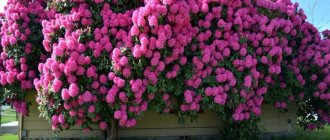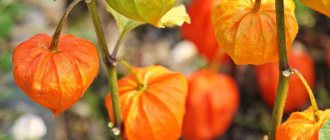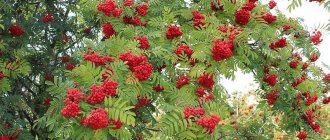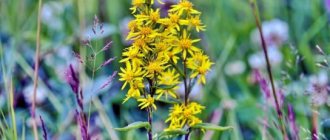Clary sage is an easy-to-care aromatic herb. Its bushes are decorative and attract pollinating insects to the garden, and the magical aroma soothes and lifts your spirits. Dried leaves can be added as a seasoning, brewed into tea, or made into medicinal decoctions and infusions. Growing it will not cause you any trouble, but sage will give you a lot of benefits and positive emotions. Read about the experience of planting, harvesting and using clary sage in the article by a regular author and reader of the “Dachny Club” magazine.
Description of clary sage Voznesensky
The Mediterranean is considered to be the birthplace of the plant. Sage grows best in warm climates, but can also tolerate short-term exposure to low temperatures. In most cases, the plant lives no longer than 2 years, but the duration of the growth period depends on environmental conditions: soil, climate, care. Sometimes sage does not sprout in the second year. Increased plant viability (from 2 years or more) is less common. In the northern regions, biennial and perennial plants are rarely found.
The subshrub reaches 1 m in height. The flowering period is from June to September, but flowers do not appear constantly, but in one of the periods, 1 month long. Only leaves and inflorescences are used for medicinal purposes. They contain the greatest amount of useful substances; essential oil is also concentrated in these parts of the plant.
It must be taken into account that biennial sage blooms in the second year after planting in the ground. Annual and perennial plants produce color in the first year after planting. If in winter the temperature does not drop to a critical level, two-year-olds can produce color in the third year. To a greater extent, the viability of this type of grass is determined by environmental conditions.
The plant can withstand low temperatures - down to -30°C. However, the most preferable temperature regime is within +20°C. In such conditions, the grass develops better. It is not recommended to replant sage during active growth. To improve its properties, the plant should be planted only in sunny areas. Herbs that are grown in the shade have a weaker aroma.
The plant tolerates drought well, but develops more actively with high-quality watering. Sage can grow in different soils, but the grass grown on black soil has the best properties. At the same time there are more inflorescences. If sage grows in dry soils, it is noted that in this case its aroma becomes more intense. This is due to the high content of one of the components – linalyl acetate.
We recommend that you read the Abstract on the use of curcumin evalar
If sage has been growing on a site for a long period, essential oils accumulate in the soil, which can negatively affect the growth of young shoots. The stubble and root parts of the plant, which remain after the collection of raw materials for harvesting, have a phytotoxic effect. Remaining grass must be removed.
They contain phenolcarboxylic acids. This substance contributes to the gradual death of young shoots. Stubble and root areas have a negative impact during the decomposition process.
To reduce the intensity of the negative impact of plant residues on young sage, it is recommended not only to remove them from the ground, but also to prepare another area for growing sage. The location where the grass is grown should be changed every few years. The viability of sage increases if it is planted away from sunflowers, since these plants have low resistance to white rot.
Photo
The plant can penetrate the soil to a significant depth - up to 2 m. To get an idea of what clary sage looks like, the photo is studied first. The stem of the plant is tetrahedral. Flowers can be white, purple or light blue.
The subshrub is paniculate-branched, which is due to the presence of inflorescences elongated upward. The thickness of the stem is no more than 2 cm.
The leaves are pubescent, most of them are large, but closer to the top they decrease in size. Inflorescences reach 60 cm in height. Their size depends on how intensively the plant develops.
Tips from experienced gardeners
There are several important nuances that can make the process of growing sage in a summer cottage easier:
- watering should be regular only for the first couple of weeks, and then it should be done as needed;
- in the spring it is advisable to add fertilizers for faster growth;
- it is necessary to remove weeds in a timely manner, otherwise the flower will die;
- if you grow sage near other crops that are exposed to parasites, they are likely to go away;
- plants cut in the fall should be put into a compost pit in order to fertilize the soil with the resulting humus in the spring;
- the top and flowers can be used for medicinal purposes, but shoots from annual trees are collected only in early autumn.
Do not use large amounts of fertilizers. The flower is unpretentious, and they are required only to enhance flowering. Excess nitrogen in the soil, which is found in all organic matter, can damage the root system of the flower.
Plant properties
Clary sage essential oil is the main product for which this herb is grown. In addition, dry raw materials are often used. Sage has an astringent taste. The aroma is bitter, quite strong, which is due to the large amount of essential oil in the composition. If you plan to grow such a plant, its properties and applications are studied at the initial stage. Chemical composition of the herb:
- linalyl acetate;
- linalool;
- linalyl fornisate;
- alpha and beta pinenes;
- limonene;
- camphene;
- myrcene;
- alloocymene;
- n-cymene;
- acetic, formic and other types of organic acids;
- hydrocarbons of different types;
- fatty oils as a source of linoleic acid;
- saponins;
- flavonoids;
- aromatic resins;
- phytoncides;
- tannins;
- vitamin P and PP;
- The root part of the plant contains coumarins.
The concentration of essential oil increases to a maximum value during the fruiting period. If tannins are important, the plant is harvested in mid-autumn. The healing properties of sage are also diverse:
- antitumor;
- antibacterial;
- anti-inflammatory;
- wound healing;
- regenerating;
- essential oil manifests itself as an aphrodisiac;
- moderate pain reliever;
- venotonic.
We recommend that you read Chamomile and gastritis
Sage normalizes blood circulation, so it is often used for varicose veins, hemorrhoids and other pathological conditions accompanied by impaired venous flow. Pregnant women are not recommended to use sage due to the negative effect on the tone of the uterus, which leads to premature birth in the 2nd and 3rd trimesters, miscarriage in the early stages.
Sage essential oil is involved in metabolic processes at the cellular level. Thanks to it, the process of sebum secretion is normalized. This helps improve the appearance of the outer skin. The plant has a positive effect on the nervous system, as it is characterized by moderate sedative properties.
Sowing rules
This is a relatively heat-loving plant. Seed germination begins at a temperature of +8+10°C, but conditions at +25+28°C should be considered optimal. Therefore, if you have few seeds, then it is better to sow it in peat-humus pots and transfer it outside at 40-50 days of age. And the probability that some plants will bloom is higher, and the consumption of seeds is not so great.
In the phase of 10-12 pairs of leaves, sage rosettes can withstand frosts down to -28-30°C. Frost resistance largely depends on the physiological maturity of plants that have gone into winter. It does not like alternating thaws with severe frosts; this significantly reduces winter hardiness. Intensive growth of above-ground mass and reproductive organs occurs better at an average daily temperature of +19+21°C, but oil accumulates in hot weather. The hotter the summer, the more fragrant the plants are. And, of course, for active lush flowering you need the brightest and sunny places. Even if you didn’t have enough time to weed it in time and it ended up among weeds in the first month and a half of its life, this will affect flowering. You also need to take care that the seedlings are not too dense - this also adversely affects its appearance - the flower stalks turn out elongated and rather weak.
On highly fertile soils, the optimal density should be considered 25-28 plants per 1 m2, and on poor low-humus soils - 15-20. The density of plant standing significantly affects the development of clary sage inflorescences. In dense crops (40 pcs/m2 or more), simple capitate inflorescences are formed in the upper part of the stem. They have little branching, so they quickly fade and lose their essential oil content. Actually, there will be nothing to clean up. When planted sparsely (7-8 plants per 1 m2), sage bushes heavily, side shoots become lodged, which also does not add decorative value.
Before sowing, the area must be carefully and deeply dug, add compost at the rate of 1-2 buckets per m2 (the poorer the soil, the more), add superphosphate and ammonium nitrate at 20-30 g/m2 and cover the fertilizers with a hoe or shallow digging. If the soils are acidic, then it is necessary to add dolomite flour. This is more relevant for the Non-Chernozem Zone.
The sowing time is determined by the growing location. In the Krasnodar Territory, for example, the best results are obtained by winter sowing in late October - early November. Shoots appear in spring. In our conditions, they are sown in early spring. Sow to a depth of 3-4 cm with row spacing 70 cm wide. Or seedlings are planted according to a 25x40-60 cm pattern. Before sowing, you should not try to soak the seeds in various stimulants. They get slimy and then there is no way to sow these slippery balls. If you really want to “stimulate” it, then after sowing and not yet filling it with soil, water the furrow with the stimulant, and only then sprinkle it.
After the emergence of seedlings, they are thinned out if necessary. Care includes weeding and loosening, and, if necessary, disease control, but in garden plots they rarely bother. In dry summers, you need to water the plants several times a season.
Sage of the second year of life is harvested for seeds when they ripen in the lower and middle parts of the central inflorescence. It is more problematic to collect seeds from plants of the first year of life, since they bloom quite late and the seeds are formed in the unfavorable conditions of September, when heavy rainfall causes them to get wet and slime right in the inflorescence.
About the properties of clary sage - in the article Clary sage: medicinal properties and uses.
Photo: Rita Brilliantova
This is interesting: How to grow a plum from a seed and whether it will bear fruit
Landing at the dacha
Despite the fact that there are no strict requirements for the growing conditions of Clary sage Voznesensky 24, it is better to plant and care for this plant in a more suitable climate and soil. Due to this, the aroma and external characteristics are improved. Additionally, there is an increase in the plant's resistance to diseases. It is preferable to choose a site for planting on the south side. If sage grows in a shady area and receives insufficient sunlight, its development slows down.
It is better to choose a planting location where there are no drafts. The preferred average daily temperature is up to +21°C. The soil can be any; sage is not picky about its type and can grow anywhere. However, the plant exhibits its best properties when it is planted in slightly acidic, fertile soils containing sufficient amounts of phosphorus, nitrogen, and potassium. Intensive growth is observed in loamy, sandy soil. It is not recommended to plant sage in wetlands where groundwater lies close to the surface.
If we grow sage in the country, we can consider different methods:
- vegetative (dividing the bush);
- planting seeds.
In the first case, the procedure should be started closer to the end of summer. It is necessary to dig up the bush. It is divided into several individual plants; for this you need to use a shovel or knife. To reduce the risk of disease development, the root is treated with a product with fungicidal properties. For the winter, the seedlings are left in a shelter. It can be planted in the soil in the spring. In some regions, planting is carried out at the end of autumn.
The soil needs to be prepared. It is dug up at a significant depth. This will allow the root system to develop better. Then you need to add compost. Its amount is determined taking into account the properties of the soil: the poorer it is, the more fertilizers will be required. Use 1-2 buckets per 1 m².
Growing from seeds
This growing method is most often used. There are several possibilities:
- self-seeding: it is hoped that the seeds themselves will fall into the ground as the plant fades;
- from seeds in spring or autumn;
- preparing seedlings for planting in spring.
We recommend that you read the benefits of black rice
The best option is the method of planting seeds in the autumn while they are fresh (applied immediately after collection). Preparation of planting material is carried out at the stage when the plants have not yet fully matured (up to 70%). The inflorescences are cut off and hung indoors. To prevent seed loss, a covering is placed underneath.
There is no need to pre-soak the planting material. The seeds are planted in prepared (dug up, fertilized) soil. The depth of the holes is no more than 2 cm. The recommended distance between them is 45 cm. To prevent planting material from germinating ahead of time, it is laid in the soil before the first frost.
Cultivation at home
Cultivating sage at home in a pot is practically no different from growing the plant in open ground. However, there are some nuances.
Planting in a pot
You can grow sage at home either by seed or using cuttings.
Salvia officinalis is grown as a perennial crop. Other plant varieties will have to be planted annually.
How to grow sage on a windowsill from seeds:
- For planting, it is advisable to take darkish and whole seeds the size of a pea.
- Next, the planting material should be soaked in water and germinated in a damp cloth.
- After this, the treated seeds must be distributed over the dug grooves, which should be watered a little.
- The first shoots will appear in about 3 weeks or later, depending on the variety being grown.
- The optimal temperature is +25 degrees. It is necessary to provide access to sunlight. The soil should be moistened as it dries.
Instructions for propagating crops using cuttings:
- From an adult bush you will need to cut off sprouts 10 centimeters long.
- All leaves on the cuttings should be removed except the top ones.
- Place the planting material in a container with water (the place where the cutting is cut should be fresh).
- After a couple of weeks, the shoots should take root.
Cuttings should be sent into the soil when the roots reach 3 centimeters in length.
Growing rules
By adhering to important rules for cultivating the plant, you can grow a beautiful and lush sage bush on the window.
Tips for growing home crops:
- The pot for planting the plant must have a volume of at least 1.5 liters. It is best to take a container with a volume of 15 liters so that the root system of the bush has enough space.
- Both expanded clay and pebbles can be used as a drainage layer.
- For sowing, you can take a glass, which will be enough for 6 months. Then the seedlings can be distributed into larger pots.
- Transplantation can be done using the transshipment method.
If all the rules are followed, the sage bush can be cultivated for 5 years.
Soil requirements
For sowing, the soil must be well-drained and fertile. To do this, you can take a special substrate intended for growing cacti.
You will also need to add vermiculite and perlite to the soil.
You can also use universal soil intended for growing indoor crops. But then it will be necessary to check that the acidity level does not exceed 7 units.
When using ordinary soil taken from the garden, the soil must be cleared of branches and roots, and also disinfected.
Care
It is necessary to water the sprouts regularly. Sage needs regular watering until it blooms. After this, caring for the plant will become easier: the grass can withstand arid climates for a long period. However, this does not mean that sage no longer needs moisture. If possible, it is recommended to continue regular watering.
At the beginning of spring, the first soil loosening is carried out between the rows. Sufficient depth is up to 10 cm. Then the soil is loosened if the need arises (a crust appears on the surface of the soil). It is enough to treat the soil 3-4 times a year.
Infertility treatment
One of the main qualities of sage is the treatment of infertility in women.
This remedy was used back in Ancient Egypt. In those days, it was suggested to take the decoction with a pinch of salt. To this day, clary sage is used in the form of a decoction to treat problems in the female body, only without salt.
A tablespoon of dried herb leaves is poured with 200 ml of boiling water. This mixture is simmered over low heat for 10 minutes. This procedure can be performed in a water bath. After this, the broth is infused for 30 minutes. Then it is filtered and consumed three times a day, a tablespoon.
In addition to its main purpose, this remedy improves memory. It can be used to stop lactation.
Applications of the plant
Sage is used in medicine:
- restores the functioning of the central nervous system;
- has a positive effect on the musculoskeletal system;
- improves the condition of blood vessels;
- activates the production of gastric juice;
- restores the process of sweating;
- sage tea improves kidney condition during exacerbation of various diseases;
- recovery from diseases of the upper and lower respiratory tract is accelerated;
- sage normalizes urinary function;
- exhibits a choleretic effect;
- helps alleviate the condition of bronchial asthma;
- sage slows down baldness.
The plant is also used in cosmetology:
- has a positive effect on hair;
- regulates the process of sebum secretion;
- Sage helps eliminate acne.
Uses of clary sage oil
This product is used in aromatherapy and in the production of cosmetics (face cream, care products, etc.). The essential oil of this plant is included in many perfumes. Other applications:
- food industry: alcoholic beverages and confectionery products;
- tobacco industry;
- seasoning production;
- used as a flavoring in the production of cheeses and tea;
- The plant's oil is used in medicine.
Contraindications
When clary sage is considered as a medicine, the medicinal properties and contraindications are studied before using plant-based products. It is not used in a number of cases:
- pregnancy period;
- lactation;
- severe kidney damage during an exacerbation;
- development of malignant tumors.
Relative contraindications include hypertension. In addition, the herb should not be used for a long period.
Contraindications and precautions
The use of various medicines from sage may have some contraindications. They apply to pregnant and lactating women at any stage, as well as people suffering from certain chronic diseases of internal organs:
- jades;
- hypothyroidism;
- epilepsy, various forms of neuralgia;
- polycystic disease;
- uterine fibroids.
Important! Rinsing the mouth, as well as external use of the medicine, is used with caution during pregnancy and in the presence of some of the listed pathologies. However, you should not start a course of treatment without consulting a doctor.











